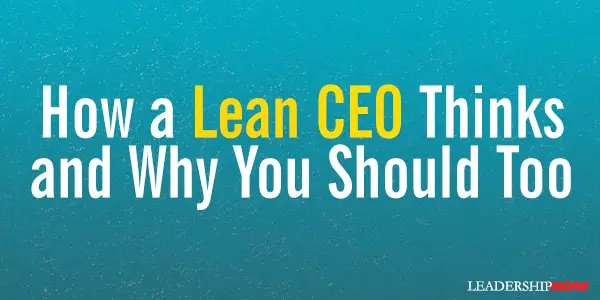 |
 |
04.22.15

How a Lean CEO Thinks and Why You Should Too The Lean CEO by Jacob Stoller gets to the thinking behind why Lean management works. I think "Lean" is a poor moniker to give the approach. It tends to make people think of cost-cutting or how to get the most work out of the fewest number of people. It sounds like a manufacturing thing. But that is misleading.
The Lean CEO by Jacob Stoller gets to the thinking behind why Lean management works. I think "Lean" is a poor moniker to give the approach. It tends to make people think of cost-cutting or how to get the most work out of the fewest number of people. It sounds like a manufacturing thing. But that is misleading.
It is a holistic approach to management. It produces excellence because it is good leadership. It is “a fundamental overhaul in the way companies manage people.” To be sure it is about creating the most value from the resources you have whether it be time, money, people, or equipment. It strips away any event that does not add value by creating leaders at all levels. Stoller points out, Lean organizations outperform non-Lean organizations for two basic reasons: Lean Brings Out the Best in People Lean is respectful of people, develops and makes use of people’s gifts. “Lean provides the antidote for the common complaint ‘I love my work, but I can’t stand all the other stuff that goes on.’ Lean sees that ‘other stuff’ as waste, and any employee who feels that frustration can lead the charge to get rid of that waste.” It builds teamwork. How can we produce the best work together? Lean Gets Leaders in Touch with Reality Management does not lack data. What is typically lacking is context. Lean provides that context. It connects every member of the team to what is really going on. A Lean organization is essentially a learning organization which makes it especially suited for uncertain times. “Lean provides a disciplined structure that allows an organization to focus resources on measurable customer-oriented goals, essentially codifying what has made the company successful. Because Lean creates a continuous improvement environment where all employees are asked for input on decisions, the Lean journey allows the CEO to naturally evolve from reactive day-to-day decision maker to proactive teacher, coach, and strategist.” Stoller begins The Lean CEO with an exceptional survey of how we got to be so wasteful. Wasteful of people’s time, energy, and talent in particular. Abundance often leads to waste and hides issues that should be dealt with. Many Lean CEOs would not have adopted Lean practices without a crisis. Stoller profiles 28 Lean CEOs in this book that have implemented Lean in a variety of industries with great success. There is a lot to glean from these pages. Here are some ideas to reflect on: Lean creates the ideal environment for motivating workers. Recognition, variety, autonomy, and the opportunity to learn are all intrinsic to the employee’s role in a culture of continuous improvement. Lean is not just a manufacturing system. It is a way of thinking about people that applies to any organization. Lean is a culture. It’s not a directive. It’s a way of thinking. It is about being open and humble. It’s about diversity of thought and understanding that good ideas come from anywhere. The Lean CEO gets to the heart of what it means to lead from anywhere. 
Posted by Michael McKinney at 10:54 PM
|
BUILD YOUR KNOWLEDGE
 

How to Do Your Start-Up Right STRAIGHT TALK FOR START-UPS 
Grow Your Leadership Skills NEW AND UPCOMING LEADERSHIP BOOKS 
Leadership Minute BITE-SIZE CONCEPTS YOU CAN CHEW ON 
Classic Leadership Books BOOKS TO READ BEFORE YOU LEAD |